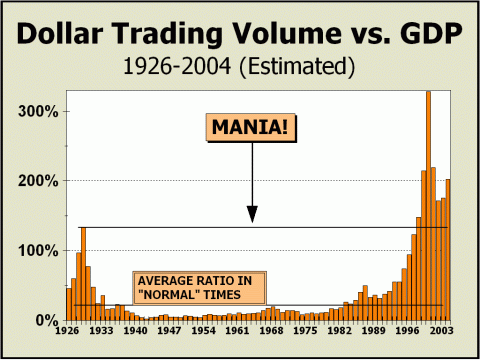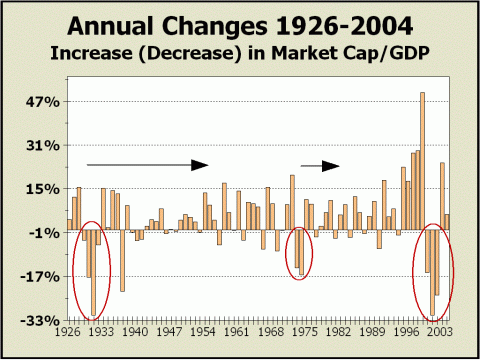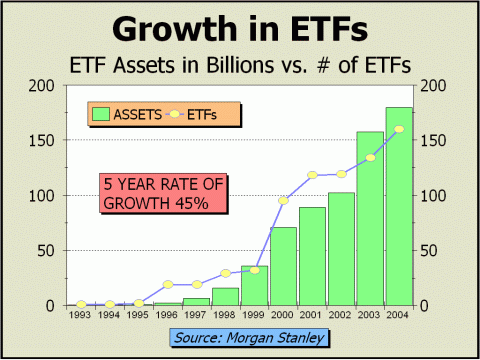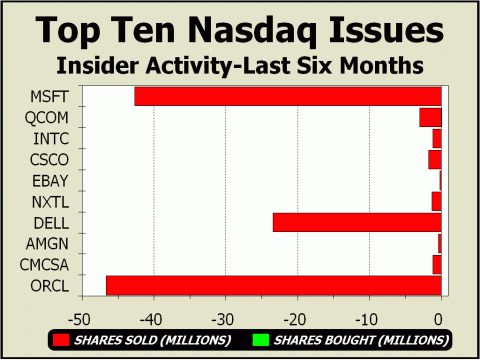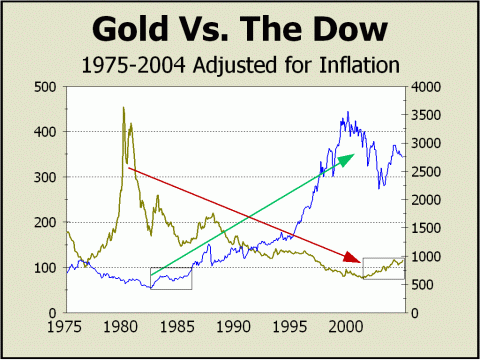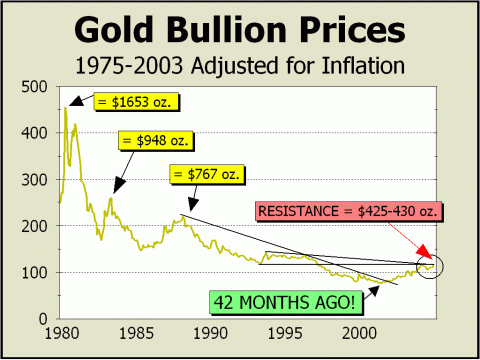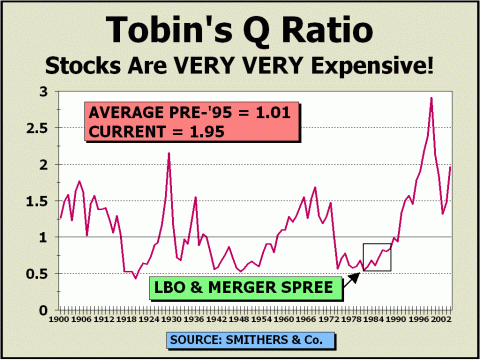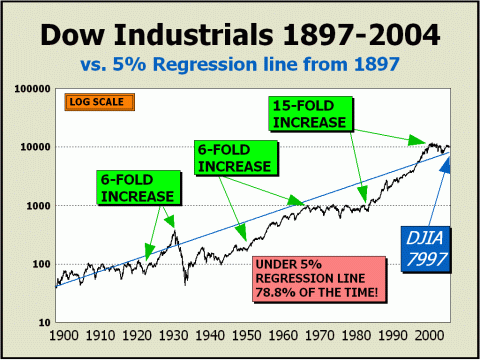
| This is our
47th report on the ongoing mania since we first published our website on
January 15, 1999. Since that time, over three million visitors have
perused our free offerings and well over one million have visited this
page. At first, we published monthly, then every other month, and
we now publish this feature quarterly. Make no mistake, it's a huge
task to put together a 3000 to 4000 word free report while composing several
other free features and then to publish a paid subscription stock market
newsletter, where our only rationales for existence are powerful commentary,
unique perspectives and reality checks that cannot be found anywhere else.
We have been told far too often that we do not charge enough for our work.
We agree. If you need to know what keeps your Editor going, check out the
testimonials on our Kudos page.
- THE VELOCITY OF TRADING - We have been keeping Dollar Trading Volume statistics since this site was first created. When the actual numbers were not made available, we devised our own methods of estimating, which we believe were never more than 1% to 2% away from an exact total. Although we are now able to obtain exact numbers from both the New York Stock Exchange and Nasdaq, our efforts to obtain same from the American Stock Exchange have been futile. According to a recent email inquiry, the ASE does not keep a separate tally and has no plans to do so. This makes our job incredibly difficult, since DTV is growing most rapidly on the Amex as Exchange Traded Funds ("ETFS") continue to take center stage away from individual common stocks. We simply do not have the time for manual computations and are again forced to estimate. Meanwhile, the nature of trading and investment in the U.S. stock market is metamorphosing into something quite perverse and terrifying and the implications for investors are dire. See our re-printed article "Encore" below for a more emphatic description of some of the mechanical processes by which prices are now impacted. Trading slowed markedly during the summer and has impacted total DTV. The slowdown in average daily volume reached roughly 18.5% on the NYSE and as much as 21.6% on Nasdaq before rebounding as the fall commenced. Yet even with a summer slowdown in place, given our expanded estimate of Amex trading, DTV appears to have risen substantially to 202.2% of Gross Domestic Product, far higher than in either of the prior two years. Remarkably, only four years after the second biggest stock price collapse in a century, DTV for the NYSE is now running at brand new record rates while trading on the Amex will probably end the year between three-and-a-half times to four times the total of the year 2000. To illustrate the fantastic extremes to which trading has gone, just one issue now accounts for roughly 2.8% (!!!) of all dollars traded in the U.S.; the Nasdaq 100 Trust, known more popularly as the QQQs. This might be comprehensible if most of the constituents were solid values, companies with long histories of rising profitability and dividends, but more often than not, constituents of the Nasdaq 100 Trust are overvalued companies with spotty performance and little if any dividend (see "Qube Qrazyness" below).
- LOST WEALTH IS A SIGNIFICANT FACTOR - Despite the new records, although wealth as measured by total market capitalization has grown, it has yet to offset the damage done by the collapse from 2000-2002. The chart measuring annual changes in wealth illustrates an extreme danger that may incapacitate price recovery for years to come. First, we focus on the only three episodes of wealth loss worthy of mention, the period from 1929 to 1932, 1973 and 1974, and the recent drubbing of 2000-2002. The middle episode is vastly different from the first and the last. The Dow actually registered a peak in 1966 that was only nominally exceeded at the end of 1972, before the middle two year drubbing took place. Prices for the broader market of U.S. stocks had actually been in decline for quite some time previous to December 1972. Our point is that the losses by comparison to the first and last episodes shown were comparatively small and that recovery was far better enabled thereafter. From the bear market low of October 1974, it was less than eight years until a new secular bull market commenced (see second arrow). However, from the bear market lows in 1932, one can make the case that a new secular bull market was not in progress until approximately 1949, when WW2 was long over and soldiers were once again absorbed gainfully into the workforce. One could also make the case that recovery only arrived when the Dow finally traded above its 1929 high in 1955 (see first arrow). The size of the losses sustained during the collapse of the Roaring Twenties ensured that a full recovery would take years to unfold. Given the scope of the losses from 2000-2002, it is very easy to make a similar case for the next decade, and perhaps even longer. Seen from another perspective; the decline in total market cap equaled nearly one-third of GDP in both 1932 and then again, in 2001. The 1929 episode is the only prior instance that is similar to what occurred after the recent mania broke. There is no guarantee that our experience afterwards must be exactly the same, i.e., a depression, but one would logically infer that some of the investing class is now permanently gone from the scene. If we are correct in that assumption,
The following article appeared in the August 16th issue of Crosscurrents and is re-printed here for its relevancy regarding the continuing mania for U.S. stocks. A brief update will appear in the November 15th issue of Crosscurrents and a more comprehensive update with charts will appear before the end of the year. This issue will also have an updated perspective on gold (see below). - ENCORE! - Every quarter, Morgan Stanley releases a report on the growth of Exchange Traded Funds ("ETFs") and every quarter we examine the implications. Growth has been spectacular. Total assets of ETFs have risen at a better than 45% annualized rate since 1999 and the number of ETFs have risen at a comparable rate. Thirteen of the ETFs trade an average of over one million shares per day and the total annual dollar trading volume of ETFs traded is now more than $3.25 trillion, approximately 13.2% of all trading on U.S. markets, a percentage that grows with each passing day. The Nasdaq QQQ trust is unarguably the most popular stock trading entity ever developed, averaging over 105 million shares every day and by itself is now responsible for roughly one of every $27 traded in the stock market. Despite the many arguments put forward by academics concerning the legitimacy of derivatives and their importance in coercing an "efficient" market, we strongly believe the evidence is to the contrary. By far the most rapid development of ETFs has been in the period from 1999 to date, and instead of stock prices benefiting from efficiency, both Nasdaq and the S&P 500 ballooned into a manic peak and then collapsed and still remain depressed, yet overvalued. Given that ETFs are all indexes of one sort or another, the proclivity towards indexing has increased hand-in-hand with their extremely rapid growth. Tacked on to the effects of plain vanilla S&P indexing, we have ensured an environment where stocks cannot be efficiently priced, except by accidental occurrence. To very briefly explain the paradox, which we have gone over countless times before, the vast majority of indexing favors higher capitalization issues. Regarding this circumstance, assume an index of three stocks; stock A is capitalized at three times stock C and stock B is capitalized at two times Stock C. For every $6 invested in the index, $3 must necessarily be invested in Stock A, $2 in Stock B and $1 in Stock C. The investments are made totally with respect to capitalization and each company's fundamental prospects has absolutely no bearing on the amount invested. Thus, more money is eventually thrown at companies with poor prospects and less money is invested in companies with superb prospects. The result: pricing inefficiencies. Over time, the inefficiencies must grow and eventually corrupt the investment process, rewarding and penalizing companies in relation to their size or lack thereof. To those who are quick to defend the derivative environment, particularly the rapid growth in indexing and ETFs, we can only demur by pointing out that all movements, however small, create inefficiencies. The proof is that prices constantly change, even from moment to moment. In the past, and at least in theory, inefficiencies could eventually be corrected by investors or speculators acting on fundamentals and pricing securities appropriately to account for new or ongoing developments. As indexing and growth in ETFs continues unfettered by any notion of fundamental prospects, the ability for investors and speculators to act on the prospects for individual issues is simply overwhelmed by indexing and other trading, including but not limited to program trading activity. There are 160 ETFs trading today. Growth is so phenomenal that there are plans in place for an additional 37 ETFs to be listed before the end of the year. Where does it end? The U.S. stock market is 99% represented by the Wilshire 5000, correct? Yet, there are 4600 mutual funds and as many as 9000 hedge funds trading not only the very same 5000 issues, but virtually hundreds of sectors and indexes comprised of the very same shares! Question: where is the fiduciary responsibility for money managers to invest in the best company - the company with the best prospects? Answer: missing, for the most part. A significant reason why tech weightings ballooned during the mania was growth in indexing and the creation of ETFs. There are now almost 615 million shares of the QQQ Trust outstanding. Each share of the trust is comprised of one share of each of the 100 constituents. Those shares were either purchased and deposited or simply deposited to exchange for shares of the trust. Either way, a tremendous demand was created. Enter the mania until finally, the mania exited, stage left. ETF growth explodes, financial stocks take center stage. Total Stock Market VIPERs are now comprised of 22.2% Financial issues; iShares Russell 3000 are now comprised of 21.6% financial issues; iShares S&P 1000 Index is now comprised of 20.3% financial issues. Can someone say "encore?"
- QUBE QRAZINESS - Now that we've examined our views of August 2004, a new perspective is in order. As an example of just how lunatic the ETF trend has become, let us concentrate for a moment on the top ten issues of the Qubes, representing 41.6% of the overall "index." There are now roughly $22.8 billion worth of Qubes trading each day; about one-sixth of the whole ball of wax. That's right, the entire market capitalization turns over about every six days. Well, you say, this can only be a testament to the great values found in the constituents, with participants so eager to pile on. Wrong, of course. Who can know better than insiders what corporate prospects are? If prospects are sufficiently bright, we would probably still find many more sellers than buyers as logic dictates "diversity." But the extent of selling is so pervasive that one can only assume these issues are still quite overvalued. A tally taken just a few days ago shows that for every insider buying shares of the top ten Qube constituents, there are 15.8 sellers. Worse yet, for every share purchased, 2903 are sold! If you have good eyes, you may barely be able to make out a very slight bulge in shares purchased for Qualcomm (QCOM). If we were to stretch that bar out to an itsy-bitsy eighth of an inch to make it more visible, the sell side of our chart would range out 28.6 feet to accommodate the sales of Oracle's insiders. You'd need one heckuva widescreen monitor to see that chart! Value? The average P/E for the ten issues shown is a robust 35.5 and the average yield (cough, cough) is a meager 2/10ths of a percent. Lest you think that we are castigating a small group of minor companies that have years of 20% annual growth ahead of them, bear in mind the total market capitalization of those picture is over a trillion dollars, $1,086,500,000,000 to be precise (more or less). That folks, is 7.9% of the entire market cap of the U.S. stock markets. Yet, it seems no matter how rapidly insiders sell their shares, everyone else cannot get enough of them, especially those wrapped up in the form of the QQQs.
- THE REAL BULL MARKET - The following is reprinted from the September 20th issue of Crosscurrents, but with updated charts. Another perspective will be shown in the upcoming November 15th issue. It's been quite awhile since we showed any gold charts or our reasoning on why we favor gold and gold shares as an excellent alternative to the household equity names bandied about by the talking heads on CNBC. As our chart at bottom left clearly evidences, the cycle for stocks and against gold was long lived, close to a generation. As well, please note there has been a brief lag between the top in the gold cycle and the bottom in stocks. We should infer a similar lag might take place when these cycles reverse and apparently, a lag is now in effect. Despite the rally in stocks from the October 2002 lows, we believe the cycles have shifted 180 degrees and now favor gold. Note the little rectangle that highlights action in bullion since the inflation adjusted low of April 2001. A rectangle of the same size has been placed alongside action from the inflation adjusted bear market lows of July 1982, to illustrate that the progress in gold's bull market has been significant next to the progress in the prior secular bull market for stocks. Please bear in mind that our scaling effect imparts a negative bias to the action for stocks, which was actually more significant for the same period of time.
Our close up on gold shows that we correctly pegged resistance at $423, almost to the dollar, and we did so months ago! [ED NOTE: RESISTANCE IS NOW IN THE NEIGHBORHOOD OF $430] Subscribers can check the Crosscurrents newsletter archives for the January 5, 2004 issue to verify. As gold's bull market heats up in the next few years, we should expect former peaks in resistance to be tested. The next such peak is extremely far away at $767 per ounce but if the bull market even remotely resembles the bull market for stocks, that peak could be easily achieved.
- THE REALLY, REALLY IMPORTANT "Q" - If you believed everything you heard from most of Wall Street's vaunted "strategists," it would be easy to conclude that stocks were undervalued. Yes, there were a few bears, most notably Merrill Lynch's Richard Bernstein, but bears do not get the press bulls do because that's how Wall Street operates. The objective is to increase assets under control, and only a positive spin will suffice on that score. Thus, at the beginning of the year, Prudential's Ed Yardeni predicted a year end Dow at 11,700 and the S&P at 1300. Goldman Sach's Abby Joseph Cohen forecast the Dow at 11,800 and the S&P at 1250. We're not going to list the surmise of all, since we have limited space but just take a moment to reflect; can you remember the last time when most of Wall Street was bearish? And the time before that? We'll answer for you - the last time was late in 1990. The time before that was late in 1987 and the time before that was late 1974. In each case, doom and gloom was pervasive before stocks took off in a one way race to the upside. With strategist allocations to stocks averaging between 60% to 70% for virtually all of the last five years, their positions clearly implied value. Was there indeed, value? We examine "Tobin's Q" ratio from time to time to answer that question. What is Tobin's Q? The ratio was devised by James Tobin of Yale University, a Nobel Laureate in Economics, who hypothesized that the combined market value of all the companies on the stock market should be roughly equal to their replacement costs. Sure makes sense. if the ratio is too low, one simply buys operating companies that are publicly traded; if the ratio is too high, one could start operations, sell the company to the public and then begin the process all over again. The calculation is market value of assets divided by their replacement value. Sounds simple enough. If the ratio is much below 1, stocks are undervalued. If the ratio is much above 1, stocks are overvalued. Hypothetically, over the course of time, if the stock market works as intended, the ratio should average pretty close to 1. Sure enough, from 1900 through 1994, just before the stock asset bubble began to develop, Tobins Q averaged 1.01. Note the spike into the 1929 top, when stocks were overvalued by a factor of more than two. No wonder they crashed. Note the highs of 1968, when stocks were 68% overvalued. No wonder a secular bear market came into play. Note the highlighted box that begins in 1981, when Q fell to .55, meaning stocks were extremely UNDERvalued. Prices would have to rise by nearly 82% to return Q to par. No wonder everyone was getting into the Leveraged Buyout (LBO) and Merger game. Stocks were raging bargains. After soaring to an unbelievable 2.91 in 1999, how could there be any consequence other than a collapse? And stocks dutifully responded, Nasdaq was crushed by 78% and the broad S&P index was neatly halved. But the typical reaction of a return to value never did occur. Tobin's Q fell no further than 1.32, meaning stocks were still 32% OVERvalued when the supposed new bull market commenced. With Q again soaring
and stocks now 95% OVERvalued,
- A SECULAR BEAR FOR 8 MORE YEARS? - The 5% regression line pictured below rises at an annualized rate of 5% over time. Why did we choose 5%? For the sake of fairness. Ex-dividends, from 1907 through 1994, before a veritable mania commenced, all rolling twelve-month periods averaged annualized gains of 4.37%. Thus 5% should be generous. When we first showed this chart some years ago, we actually opined that the regression line would eventually have to be touched before the fallout from the mania could possibly conclude. Despite the apparent breech you see on our chart, the line was never actually touched on a closing basis and was only barely penetrated intraday as the Dow plunged to a bear market print low of 7197 on October 10, 2002. Given the track record of the last 104 years, it is an entirely logical assumption that the Dow will remain under the regression line for a substantial period of time before the next secular bull market can commence. The regression line is now at 7797, and although that would not represent a new bear market low, bear in mind that if the Dow trades below the line for any appreciable length of time, the odds for a new low below the October 10, 2002 will likely increase as investors lose their nerve, their composure and their money. Bear in mind that the regression line rises SLOWLY. For the line to incline to where the Dow closed to celebrate the Election victory of George W. Bush on November 3rd, we will have to wait until September 19, 2009. For the line to incline to the identical level as the all-time 11,722 closing high of the Dow, we will have to wait until September 2, 2012! Our own long-standing long term target for the Dow is 6400, a number we derive from several aspects, not the least of which is the poetic justice of a return to the approximate level from which Fed Chairman Alan Greenspan uttered the immortal ponderings about "irrational exuberance," a cogent analysis that was never acted upon. Given the greed evidenced during the greatest stock market mania of all time, "poetic justice" is far from the worst way the bear market could end.
Just how important are Qs, as our article title suggests? As the greatest entity ever developed for trading, the Nasdaq 100 Trust "Qubes" certainly tell us a lot about the character of the U.S. stock market. Not only does speculation rage on, it does so in quantities never seen before. And does so via an entity where insiders cannot wait to part with their ownership of the constituents, shares which reek of overvaluation. Also, can Tobin's Q ratio near 2 be considered anything other than an imminent danger signal? These two Qs with two entirely different slants paint a perfect picture of what is at work with U.S. stocks. .... ongoing speculation and overvaluation. The pictures we illustrate are candid snapshots of an ongoing mania. They should raise Questions and hopefully, we have provided some answers. By the way, one final Q, in the form of a Quote: "The financial
world remains, alas, dangerously divorced from economic reality.
High
Targets for 2004 (highs probably already occurred - these are now very
low odds except for SPX):
2004 lows have already occurred NEXT ISSUE: OUR 2005 HIGH & LOW TARGETS Long
Term Targets for ultimate bear market low - now most likely to occur in
2006
THE CONTENTS OF THE ENTIRE WEBSITE ARE COPYRIGHT 2004 ALAN M. NEWMAN I hope you have enjoyed your visit and please return again. If you know anyone who might be interested in seeing what we have to offer, we'd be happy to have them visit as well! Alan M. Newman, November 6, 2004 All information on this website is prepared from data obtained from sources believed reliable, but not guaranteed by us, and is not considered to be all inclusive. Any stocks, sectors or indexes mentioned on this page are not to be construed as buy, sell, hold or short recommendations. This report is for informational and entertainment purposes only. Samex Capital, Alan M. Newman and or a member of Mr. Newmanís family may be long or short the securities or related options or other derivative securities mentioned in this report. Our perspectives are subject to change without notice. We assume no responsibility or liability for the information contained in this report. No investment or trading advice whatsoever is implied by our commentary, coverage or charts. |
